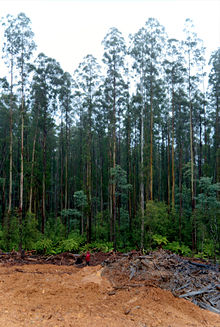Bushfire in Victoria, 1939
The Bushfire in Victoria 1939 , also known as Black Friday Fires in Australia , occurred in Victoria on January 13, 1939 and was one of the most destructive bushfires in Australia , burning an area of 20,000 km², killing 71 people, completely destroying several cities and beyond led the Royal Commission to investigate the 1944 fire protection legislation in Victoria.
Over 1,300 houses and 69 sawmills burned down, and 3,700 buildings were destroyed. It is estimated that around three-quarters of the state of Victoria were directly or indirectly affected by this disaster. The Royal Commission issued a statement in which it was stated: "the whole State was alight on Friday, January 13, 1939" (German: "On Friday, January 13, 1939, the entire state was on fire").
conditions
In January 1939, the capital Melbourne recorded the highest temperatures recorded there at that time: 43.8 ° C on January 8th and 44.7 ° C on January 10th. On January 13, the day of the bushfire, the temperature reached 45.6 ° C, the hottest temperature in the following 70 years, although according to unofficial measurements the temperature of February 6, 1851, the devastating bushfire in Victoria in 1851 , 47 ° C.
The summer of 1938/1939 had been hot and dry, and several brush fires broke out in early January that struck many areas of Victoria. When a strong north wind came up on February 13, the scattered bushfires united to form a massive fire front.
Destruction
Most of the destruction occurred in the mountainous and alpine areas of the northeast and around the southwest coast of Victoria. The Acheron , Tanjil Valley , Thomson Valley and Grampians National Park were also affected. Five cities, Hill End , Narbethong , Nayook West , Noojee (except the hotel) and Woods Point were completely destroyed and then not rebuilt. The towns of Omeo , Pomonal , Warrandyte (now a suburb of Melbourne ) and Yarra Glen were also badly destroyed.
At about the same time, the bushfires were burning through the Adelaide Hills . Ashes from these fires fell as far away as New Zealand . The bushfire did not come under control until two days later when rain fell on the night of January 15.
Main fire
The following five areas were mainly affected, the smaller bushfires affected the areas of East Gippsland , Mount Macedon , Mallee Peninsula and Mornington Peninsula .
The main fires in order of size are listed here:
- Yarra Ranges in the Victorian Alps
- Portland
- Otway Ranges
- Grampians National Park
- Strzelecki Ranges
Affected cities
Cities that were either damaged or completely destroyed were:
Central Victoria
- Dromana
- Healesville
- Kinglake
- Marysville
- Narbethong - destroyed
- Warburton
- Warrandyte
- Yarra Glen
East Victoria
- Hill End - destroyed
- Nayook West - destroyed
- Matlock - 15 people died in a sawmill
- Noojee - destroyed
- Omeo
- Woods Point - destroyed
West Victoria
- Pomonal
- Portland
Long term effects
The subsequent investigation by the Royal Commission under Judge LEB Stretton , known as the Stretton Inquiry , found that the fires were mainly caused by humans, mostly by careless campfires and fire clearance. The report made a number of proposals for forest administrations and fire safety, such as the construction of fire towers and a network of paths and roads. Organizationally, three fire service organizations were set up in Victoria, the Forests Commission (today DSE), the Country Fire Authority (CFA) and the Metropolitan Fire Brigade , which protects the city of Melbourne. Furthermore, a training course on targeted, safe burning was set up, which has existed to this day.
These bushfires also led to the enactment of the Forests Act in Victoria, which transferred responsibility for fire protection and publicly owned land and fire fighting private property to the above fire protection organizations.
The effects of bushfires show up over the years, and some trees destroyed by the fires are a reminder to this day. In the affected areas, the soils take a long time to recover from the effects of the fire, and the drinking water can be contaminated with ash and dirt for years, as these substances can be washed into the drinking water areas.
Comparison with other Australian bushfires
Compared to other bushfires in terms of loss of life and property destruction, it was one of the most destructive fires to have ever occurred in Australia. Only the 1983 Ash Wednesday Bushfires and the 2009 Victoria bushfire caused more deaths. The bush fire of 1939 burned the second largest land area compared with the Australian bushfires with 20,000 km² after the bush fire in Victoria in 1851 with 50,000 km².
literature
- Tom Griffiths: Forests of Ash 2002
Individual evidence
- ↑ Wendy Lewis, Simon Balderstone, John Bowan: Events That Shaped Australia . New Holland, 2006, ISBN 9781741104929 , pp. 154-158.
- ^ Argus Newspaper (Melbourne, Victoria), Saturday 28 June 1924
- ↑ a b c d dse.vic.gov.au : Black Friday - 1939 Victoria, in English, accessed December 2, 2011
- ↑ abc.net.au ( Memento of the original from January 2, 2014 in the Internet Archive ) Info: The archive link was inserted automatically and has not yet been checked. Please check the original and archive link according to the instructions and then remove this notice. : Royal Commission. Major Recommendations , accessed December 2, 2011
Web links
- dpi.vic.gov.au : Picture gallery of the 1939 bush fire
- dse.vic.gov.au : Current status of controlled bushfires (English)
- catalogue.slv.vic.gov.au : Royal Commission report at the State Library of Victoria
